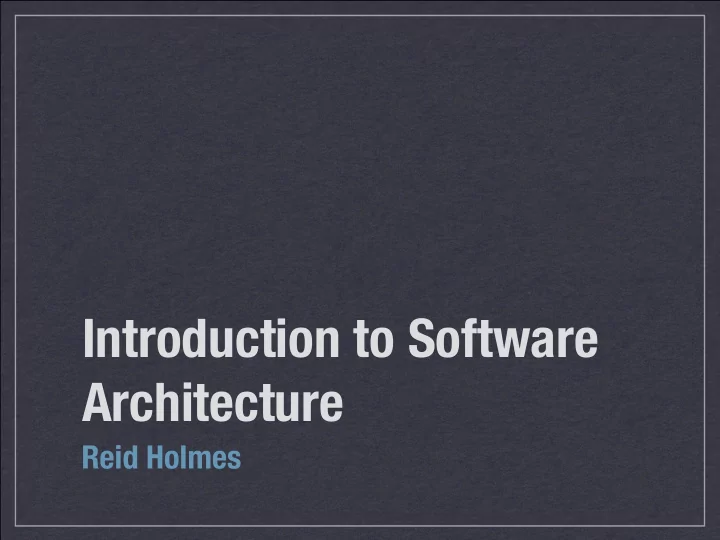

Introduction to Software Architecture Reid Holmes
Architecture ‣ Architecture is: ‣ All about communication. ‣ What ‘parts’ are there? ‣ How do the ‘parts’ fit together? ‣ Architecture is not: ‣ About development. ‣ About algorithms. ‣ About data structures. REID HOLMES - CPSC 410: ADVANCED SOFTWARE ENGINEERING
What is Software Architecture? ‣ The conceptual fabric that defines a system ‣ All architecture is design but not all design is architecture. ‣ Architecture focuses on those aspects of a system that would be di ffi cult to change once the system is built. ‣ Architectures capture three primary dimensions: ‣ Structure ‣ Communication ‣ Nonfunctional requirements REID HOLMES - CPSC 410: ADVANCED SOFTWARE ENGINEERING
Logical Web Architecture cs846.html index.html cs446.html a1.html a2.html project.html REID HOLMES - CPSC 410: ADVANCED SOFTWARE ENGINEERING
Physical Web Architecture REID HOLMES - CPSC 410: ADVANCED SOFTWARE ENGINEERING
Dynamic Web Architecture GET cs446.html a c . o o l r e 200 t a w u GET 200 scholar.html a m c . o e c l g . r o e o t s g d n e i r f REID HOLMES - CPSC 410: ADVANCED SOFTWARE ENGINEERING
Non-functional requirements ‣ Technical constraints: restrictions made for technical reasons ‣ Business constraints: restrictions made for business reasons ‣ Quality attributes: e.g., the ‘ilities’ ‣ Scalability ‣ Security ‣ Performance ‣ Maintainability ‣ Evolvability ‣ Reliability/Dependability ‣ Deployability REID HOLMES - CPSC 410: ADVANCED SOFTWARE ENGINEERING
ANSI/IEEE 1471-200 ‣ “Architecture is the fundamental organization of a system, embodied in its components, their relationships to each other and the environment, and the principles governing its design and evolution” REID HOLMES - CPSC 410: ADVANCED SOFTWARE ENGINEERING
Eoin Woods “Software architecture is the set of design decisions which, if made incorrectly, may cause you project to be cancelled.” REID HOLMES - CPSC 410: ADVANCED SOFTWARE ENGINEERING
Philippe Krutchen ‣ “The life of a software architect is long (and sometimes painful) succession of sub-optimal decisions made partly in the dark. REID HOLMES - CPSC 410: ADVANCED SOFTWARE ENGINEERING
[TAILOR ET AL.] So what? ‣ What makes building systems so hard? ‣ Young field. ‣ High user expectations. ‣ Software cannot execute independently. ‣ Incidental di ffi culties [Brooks MMM]. ‣ Problems that can be overcome. ‣ Essential di ffi culties [Brooks MMM]. ‣ Those problems that cannot be easily overcome. REID HOLMES - CPSC 410: ADVANCED SOFTWARE ENGINEERING
[TAILOR ET AL.] Essential Difficulties ‣ Abstraction alone cannot help. ‣ Complexity ‣ Grows non-linearly with program size. ‣ Conformity ‣ System is dependent on its environment. ‣ Changeability ‣ Perception that software is easily modified. ‣ Intangibility ‣ Not constrained by physical laws. REID HOLMES - CPSC 410: ADVANCED SOFTWARE ENGINEERING
[TAILOR ET AL.] Attacks on Complexity ‣ High-level languages. ‣ Development tools & environments. ‣ Component-based reuse. ‣ Development strategies. ‣ Incremental, evolutionary, spiral models. ‣ Emphasis on design. ‣ Design-centric approach taken from outset. REID HOLMES - CPSC 410: ADVANCED SOFTWARE ENGINEERING
[TAILOR ET AL.] Architectural approaches ‣ Creative ‣ Engaging ‣ Potentially unnecessary ‣ Dangerous ‣ Methodical ‣ E ffi cient when domain is familiar ‣ Predictable outcome ‣ Not always successful REID HOLMES - CPSC 410: ADVANCED SOFTWARE ENGINEERING
[TAILOR ET AL.] Design process 1.Feasibility stage: • Identify set of feasible concepts 2.Preliminary design stage: • Select and develop best concept 3.Detailed design stage: • Develop engineering descriptions of concept 4.Planning stage: • Evaluate / alter concept to fit requirements, also team allocation / budgeting REID HOLMES - CPSC 410: ADVANCED SOFTWARE ENGINEERING
[TAILOR ET AL.] Abstraction Definition: ‣ “A concept or idea not associated with a specific ‣ instance” Top down ‣ Specify ‘down’ to details from concepts ‣ Bottom up ‣ Generalize ‘up’ to concepts from details ‣ Reification: ‣ “The conversion of a concept into a thing” ‣ REID HOLMES - CPSC 410: ADVANCED SOFTWARE ENGINEERING
[TAILOR ET AL.] Level of discourse ‣ Consider application as a whole ‣ e.g., stepwise refinement ‣ Start with sub-problems ‣ Combine solutions as they are ready ‣ Start with level above desired application ‣ e.g., consider simple input as general parsing REID HOLMES - CPSC 410: ADVANCED SOFTWARE ENGINEERING
Separation of Concerns ‣ Decomposition of problem into independent parts ‣ In arch, separating components and connectors ‣ Complicated by: ‣ Scattering: ‣ Concern spread across many parts ‣ e.g., logging ‣ Tangling: ‣ Concern interacts with many parts ‣ e.g., performance REID HOLMES - CPSC 410: ADVANCED SOFTWARE ENGINEERING
Recommend
More recommend